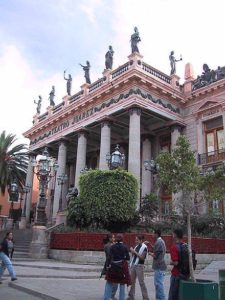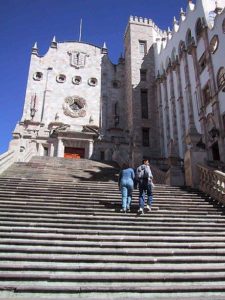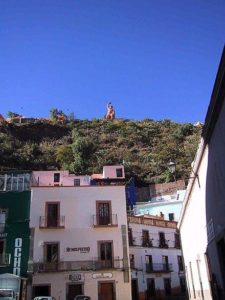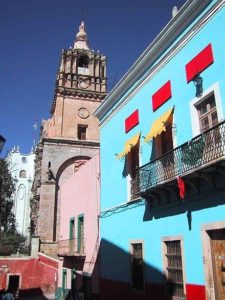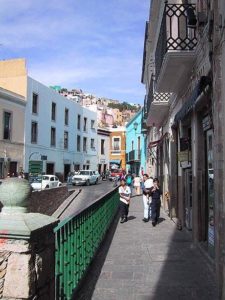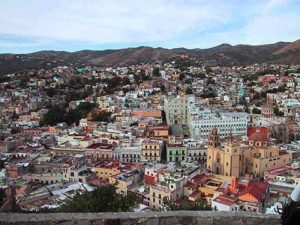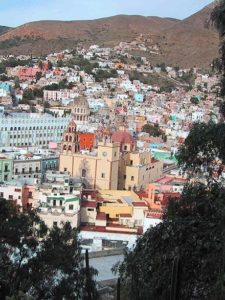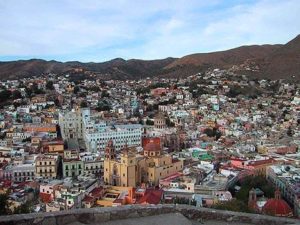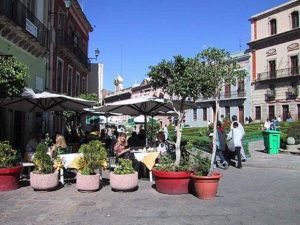Sometime during my first month in Guanajuato, the idea floated into my head of writing an article about the sonic landscape of the city. This of course includes a great deal of music, since it resounds in every corner. But surrounding the music is a larger sonic landscape, comprising a range of sounds, some magical, some painful.
When I first came to Guanajuato almost three years ago, drawn there by mysterious forces that have to do with blood and heritage as well as music, I went up into the hills to the smaller city of San Luis de la Paz. It was there that I discovered cousins I’d never known I had, and it was on that three-hour bus ride, that I had my first taste of the countryside, the topographical landscape.
I remember thinking, as we switchbacked up and up and up through the hills, higher yet than the 2,200 meters (about 5000 feet) of the city of Guanajuato, that the landscape was at once ferocious and tender. There are cruel rocky escarpments and sometimes you see the naked stone of the earth’s skeleton rising into the hills. Then, all of a sudden, around a bend in the road, there appeared a little green place with some trees, a hollow with a little grass, a protected spot in which people might be accustomed to wait for the bus or perhaps take a break from their work for a meal. These places look as inexpressibly tender as a Brahms adagio or a Pedro Infante love song, compassionate, protected and intimate. The sonic landscape, as I have continued to discover during my time here, has that same combination of ferocity and tenderness.
In México, the air is full of voices, and they are almost always very musical. There are various pregones ( preh-GOE-nehs, calls) that sound not like yells but almost like musical expressions. The ambulante (literally, walking-around vendor) in the Mexico City Metro makes his or her selling of the ballpoint pens, the city maps, the arithmetic book for children, the flashlight, any imaginable thing, a musical event. There is cadence and intonation and a leisurely sense of line. Thus the calls that I hear first thing in the morning here in Guanajuato, those of the men coming along with tanks of gas or bottles of water, have a quality of song, even though all they are calling out is the word of the thing that they’re selling.
To understand about the sonic landscape of Guanajuato, you have to understand a little about its geography. First – an acoustic consideration – it is a city carved out of the hills. There is not one street here without curves, not one surface, even the tiniest, which is level. The curves give the place mystery, and the terraced callejones (ky-yeh-HONE-es, alleyways) and subidas (soo-BEE-dahs, climbs) gives the whole place a very idiosyncratic acoustic. Sounds bounce off the mountains, and then lose their way in the complicated warren of alleyways and switch-backed subidas. Often it is hard to tell where a particular sound is coming from, or how close it is.
The second thing to understand – the social, communal aspect – is that this is a colonial city built originally on a more European model than the one to which we’re accustomed in the US. There is an abundance of public spaces in Guanajuato, and one of the most important of these is something very usual in a European city, a park or garden, a jardín (har-DEEN). There are many small plazas and jardines in Guanajuato, and each of them has its own special character and welcome.
The most central and important of these is the Jardín Unión: all paths and people pass through there at some point or another, usually sooner rather than later. It’s roughly triangular in shape and small enough to preserve a sense of closeness. One whole side is lined with hotels and restaurants, the other with small shops and other restaurants. The third lies along a street which is closed to traffic, where the Teatro Juárez, the beautiful theater built during the Porfiriato (1877-1911), the government of Porfirio Díaz, is situated. In the center, surrounded by trees whose branches meet to be espaliered into a giant hollow square, is the kiosk where the bands and other people play. Lining the generous walkway, which is tiled in terracotta-colored tiles, are benches of ornately carved cast iron, the kind that you might expect to see in Paris or Madrid or in Latin American cities where the colonial heritage is strong. On these benches, people sit and take the air, and watch the passing parade of life, because the Jardín is also a place to promenade, a place to see and be seen. There is scarcely a space to be found in the shade during the afternoon of any day, not just on holidays or weekends.
Coming here to relax and enjoy that passing parade of life is a daily routine for many people, even if just for a few minutes. In the old days, the young girls would walk through slowly, and the young men would sit, and glances would meet and the music would play and I suppose the rest is history for many of those young sweethearts who probably are eighty years old now. Because the Jardín is a central place socially, it is also a central place for a lot of the music that goes on in the public space.
The music. The other thing that struck me in those very first days here, almost three years ago, is that there is music everywhere. Live music, with living and breathing people playing it. This is partially, but not wholly, a tourist phenomenon. Often, in some nowhere place along some road in México, you will see a young man with a guitar, singing. The urge to make music here, and the joy in the making of it is very open and not constrained by fears of failing to sound like Andrea Bocelli or Michael Bolton or Luciano Pavarotti.
Every afternoon starting at about 3 pm (the time for comida, the afternoon meal), the mariachis gather in the Jardín. Soon afterwards they will start to play. It is not unusual to have two or even three mariachi bands playing, for clients at restaurants, which are side by side. Cheek by jowl with this, you may see some itinerant guitarist striking up a song for 10 pesos (about $1.10 US) for someone who has the urge to hear one.
I sat in the Jardín recently with a friend who’d just arrived from the States after what amounted to a lengthy and heartbreaking absence from Mexico. A former rumbero (rumba band musician) and percussionista, he hadn’t heard live mariachi music for longer than he wanted to think about. For over an hour, we sat at an outdoor table at the Santa Fe restaurant and listened to mariachi from one ensemble and then another, throwing song titles at them and watching them cast about in their memories for the obscure ones. By the end everyone (almost all Mexicans) in the restaurant was listening and one couple was dancing. On one of the benches along the walkway outside the restaurant, an old lady and her granddaughter sat and listened, enjoying their ice creams, making us feel that in some fashion we’d helped to prolong this music for another generation. So the sharing and enjoyment of this music becomes a communal and social activity from which everyone gets pleasure.
On Tuesdays, Thursdays, and Sundays, the Symphonic Band of the State of Guanajuato plays in the Jardín. They are often distinguished more by their enthusiasm than by their intonation, but who cares. They have improved a great deal in recent years, I am told, and I am delighted that they are there playing in the kiosk in the Jardín.
And let me not forget the bells. This is a city of many churches; some large and imposing, others smaller and more intimate. It seems that each has its bell tower where the bells sound the hour, half-hour, and quarter-hour in some complicated algorithm, which I haven’t yet figured out. Sometimes on feast days or other holidays, they ring even more often, some of them almost continuously for a period of 10 minutes or so. Like the churches, the bells are quite different, depending, I imagine, on the metal from which they are forged. Some are large and resonant and impressive, but there is one near my house, which sounds, very plain and low-tech, like the bell of some tiny church in the middle of nowhere in 1500-something.
The really wonderful thing about the bells is that all the bell ringers are actual human beings. Each church has its campanero who is responsible for ringing the bells. I have some friends here who, although they are enchanted by the “idea” of the bells, wish they would not ring at night! However, I find them a comforting sound.
These are some of the tender sounds. The ferocious ones are largely associated with automotive traffic, and so belong exclusively to the street where there are cars and buses.
To go to the Escuela de Música, where I teach, I walk down my subida, a matter of about five minutes along many twists and turns, to tranquil Plaza San Francisco. Another two or three minutes and I am waiting for my bus on a little island in the middle of a small street (there are no large streets in Guanajuato, the generous boulevards of Mexico City don’t exist here).
Suddenly, a horrendous squealing of brakes interrupts the serenity of Plaza San Francisco, and I get on the bus. We move, with a horripilating grinding of gears. We encounter the tope (TOH-peh, speed bump), which lies just ahead, before the sharp curve in the street. Topes are a Mexican phenomenon, which ensure that anyone who drives too fast encounters financial ruin in the form of a wrecked undercarriage. Many are the times I have wished we had these in the US. They are an example of the notion that you should pay the consequences of your actions. Occasionally in the U.S., I have encountered speed bumps, but they are tiny little molehills compared to the Sierra Madre of a Mexican tope, which often consists of a huge row of enormous metal balls set right into the asphalt of the street so that their top two-thirds projects out from the surface. If you don’t slow down for these babies, your car will soon be scrap metal.
Going over the tope causes sounds, which in the early days would make me think the bus was in imminent danger of falling apart. Now I know better; it is normal. We move again. More hellacious grinding of gears and engine noises that sound as though the muffler is just a fond memory. At the next bus stop, the brakes make another horrendous sound, metal against metal, deafening, shrill, on the threshold of unbearable. All this accompanied by the pregones of the guy who collects the fare and calls out to the driver when to go and when to stop.
There are the dogs, forming a whole separate rooftop community. They live up on the roofs and rarely, if ever, go down to street level. Clearly many of them are bored silly and go bananas doing their ferocious guard dog act anytime anyone walks by, no matter the hour. Late at night you can almost track the progress of a person up the subida by the barking of the dogs. Also, there are the many roosters on neighborhood rooftops and other places, who make their announcements at their personal accustomed hours, some actually in the afternoon.
There is the megaphoned voice of the female principal of the primary school, with her drill-sergeant calisthenics calls during recess at the school. There is the sound of construction: the slow deliberate tap of a hammer somewhere and, more powerfully, the pneumatic drill being used in the construction of the gondola that is supposedly being built to transport tourists up to the Pípila monument above where I live. Currently, the adventurous have to climb up my subida to get to Pípila. The giggles of the girls and the amazed cries of exhaustion (it is a taxing climb for the unaccustomed) are another part of the sonic landscape of my house. At night, in the mirador (scenic lookout place) across from my doorway you see the novios, sweethearts, pausing for a snuggly rest on the climb up or down. They speak almost inaudibly, only for each other, so you have to imagine the persuasive murmur of the novio, the (sometimes) not-quite-convinced whisper of the novia.
At the Escuela de Música, a different kind of sonic salad. It’s one of the most beautiful buildings I know anywhere, and like most who inhabit it and work in it, I treasure it in spite of its frustrations, because the whole building is imbued with the extraordinarily happy sound of people making music.
I live high up, almost directly above the Teatro Juárez and the Jardín, in a subida, which is accessible only on foot. All the sounds – music, merrymaking, dogs, roosters, parades, muffler-less buses – are there, but softened and mitigated by the strange acoustic of the place. The sounds seem to float in the air, gentled by their passage through the great shallow bowl in which the city nestles, cradled by the mountains. On my roof, a thousand sounds emerge out of the morning, their backdrop a rhapsodic twittering of birds. A parade perhaps, or the Banda Sinfónica trying their hand at Wagner or Bizet, the Indian flute of the knife-sharpener, the pneumatic drill, the hammers, the antiphonal dogs …someone singing below.
At night, the air seems to change the city’s acoustic properties. Sound as well as light seems to pass through it differently than during the day. Especially in April and May with the advent of warm weather, sounds have a softness, a gentleness. More humidity, perhaps?
Very late at night, if there is not much wind, the sound of a wild flute drifts up from La Dama de las Camelias. La Dama is the dance bar of extraordinary character at the foot of my subida, which plays predominantly traditional songs and danzón from Cuba and Veracruz. Often, you will see an older man there, dancing elegantly and eloquently. He clearly comes there only to dance and not to socialize. He is so good that in spite of his age, he dances with the most beautiful women, the best dancers. My friend the rumbero observes that this man, who dances with such passion, is missing his accustomed dance partner, perhaps the woman with whom he danced for decades who now is no longer here. I am sure that this is true. We can imagine that the music gives him a place to show his nostalgia, his passion, his mourning which is also – by virtue of his dancing – a tribute.
So this music, the music of the night which never starts until 11 p.m., which would be ruined by being played in a concert hall, also brings us together, feeds our imagination, gives rise to a communal sharing and grace, as do the mariachis in the Jardín, as do the many students striving to make great concert music in the Escuela de Música.
I go to La Dama with friends to dance, on weekends when the place doesn’t quiet down until 6 a.m., but I also go there on weeknights when it is slow, to enjoy the atmosphere and to listen to the music, because I am working on a wonderful piece by Arturo Márquez which incorporates rhythms of clave and son, and I want to fill my ears with the flute sounds and the clarinet sounds and the heart wrenching song of bolero. This piece will come into the concert hall and miraculously not be ruined by the experience, another way that music becomes transformer and transformed, making us listen, full of a thousand real and imagined histories, giving us compassion and passion, waking up our ears and our hearts.
Now you might say that all this – the side-by-side mariachis, the metal on metal of bus brakes, the dogs, the roosters, the giggles and murmurs, the calls of the gas man and the water man — sounds like a cacophony. The amazing thing is that, even up close, it is not. Why this is, I cannot tell you. Rather than a cacophony, it makes of itself a kind of polyphony, an antiphonal richness, an enjoyment of life and the capacity to sing, every day a kind of celebration.

